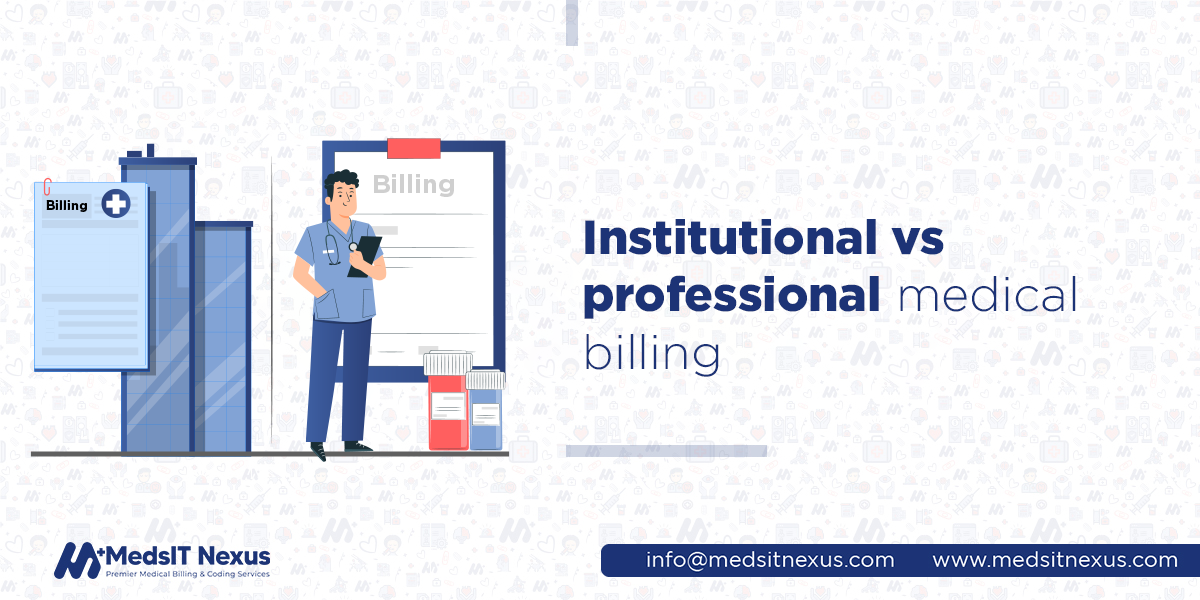Institutional Billing vs Professional Billing: What’s the Difference?

Professional and institutional billing are important medical billing and coding entities under federal
and state regulations. While both entities have a common goal of getting reimbursement for patient
services, both have different billing protocols. When you compare their surface level description, you
might initially find little or no significant difference between institutional and professional billing.
But, when you delve into the depth and look at their purposes, the methods used to bill and code them,
and their complications, you will find the crucial differences without which claim acceptance
requirements are never met.
Whether you are a medical practitioner or a person who wants to apply to a medical billing company,
understanding institutional billing vs. professional billing is imperative because without understanding
this difference, your claims will get denied, and revenue loss will occur. This post will cover the
significant differences between hospital and physician billing to ease the task and provide a deep
understanding. If you are still in the dilemma of claim denials, MedsIT Nexus comprehensively combines
professional and institutional billing services, prioritized payer relationships, optimized front-end
processes, and advanced technology to optimize your administrative process.
Difference between Institutional Billing and Professional Billing
While some billing steps are the same, some important aspects that differentiate both types of billing are given below.
Description
Institutional billing, also called hospital billing, is mainly performed for healthcare facilities,
hospitals, and clinics. It includes hospital services from the patient's admission to treatment and
covers the expenses of supplies, medicines, and room fees. The major types of services included are
inpatient, emergency, hospital-based outpatient, and other facility services, while the specialized
procedures are endoscopies, cardiac catheterizations, complex imaging, therapy services, and surgeries.
Moreover, the pillar duties of institutional billers & coders are medical billing, charging, and payment
collection.
On the other hand, professional billing encompasses the services performed by healthcare practitioners,
physicians, and other entities; hence, it is also called physician billing. Healthcare providers,
nurses, practitioners, therapists, physicians, chiropractors, and other medical staff use professional
billing to get paid for their rendered services. The types of services included for professional billing
are ambulatory and outpatient services, while the specialized procedures are routine outpatient
consults, exams, and minor procedures. The primary duties of a professional biller encompass appointment
scheduling, greeting patients at the front desk, registration & verification, and payment processing.
Differing claims - Institutional vs. professional claim
An institutional claim is used to submit a bill to an insurer for a patient who receives medical
services from an institute (e.g., a hospital). Hence, it is linked to hospital billing and centers on
billing procedures. On the other hand, professional claims are used to bill a patient who receives
medical services from an individual practitioner or physician.
Paper Claim form: The UB-04 form captures and shows the patient received institutional
services such as admission to a room, use of hospital equipment, etc., so the Administrative
Simplification Compliance Act (ASCA) mandated its usage for hospital or institutional billing. On the
other hand, the CMS-1500 claim form indicates physician services (non-institutional services). Hence, it
is linked to physician billing and centers on medical coding.
Electronic claim form (EDI 837-I vs. 837-P): Payers, particularly Medicare and
Medicaid, often require digital claim submission. Therefore, EDI 837, a
standard HIPAA electronic claim
form, is used to submit claims electronically. There are three types of EDI-837, two of which (837-I and
837-P) are used for medical billing. These are electronic versions of paper claim forms.
In institutional billing and claim formation, the electronic/digital version of the UB-04 form is 837-I,
while I depict institutional configuration. Meanwhile, in professional billing and claims, the
electronic/digital counterpart of
CMS-1500 is 837-P, while P shows the professional configuration.
Note: As a medical practitioner, you must avoid mixing EDI-37 with EDI-20 and EDI-35 because this
confusion will lead to errors. EDI-20, also called Payment Order/Remittance Advice, assists in
electronically transferring funds between payers and medical practitioners, making institutes handle
their monetary aspects such as payment reconciliation and tracking. Meanwhile, EDI-35, also called
Healthcare Claim Advice/payment, is an electronic document comprising the information on the amount,
claim denials, reasons, and adjustments, helping institutes lead the billing process smoothly.
Key aspects: The critical elements of an institutional claim are multiple services
(medical procedures, surgeries, room charges, medical equipment, inpatient care), complex coding (due to
diverse procedures, complex codes must be inserted), thorough documentation (diverse services are proved
by comprehensive documentation), and submission of the claim by facility (institutions such as hospitals
will be responsible for direct submission of the claim).
The critical aspects of professional claims include physician-centricity (the claim encompasses the
services given by an individual provider), service variety (the claim consists of multiple services like
medical consultations and procedures), clinical setting (the services mentioned to form a claim must be
rendered in a clinical setting), and direct claim submission (the independent provider is responsible
for directly submitting the claim to the respective payer).
Coding system
| Type of billing | Code type |
| Institutional billing |
|
| Professional billing |
|
Cost
Facility charges or institutional fees have increased up to four times at 531% compared to professional
fees (132%); hence, the average cost is still rising. This high price is because facility billing is
more complicated, remains open 24/7, entails room fees and
equipment charges, utilizes high technology,
and adheres to strict adherence to state and federal laws about PHI privacy and its exchange, incurring
more costs. As elaborated by the Colorado
Hospital Association, institutional or facility encompasses
the cost of service, fee for front-desk staff, nurses & assistants assisting patients, fee for staff
managing clinical data (PHI), environmental services staff doing cleaning, managed services staff,
technical services staff, and many more. Here, we have mentioned the terms technical services and
managed services, making facility charges higher than professional fees. Let's have a bird's eye view
for a better understanding.
As discussed earlier, professional services are the treatment and care given by an independent provider
(outside an institute). Conversely, technical services are non-professional services (such as IT
systems, EHR, AI, and pharmaceutical production in pharmacy), and technical charges do not include
physician's professional charges. Similarly, managed services are the typical and familiar image of
technical (IT) services, such as healthcare integration, digital workspaces, staff augmentation, data
analytics, and cost.
Reimbursement models
As the healthcare world has shifted towards quality, the importance of value-based payment models cannot be denied.
| Institutional reimbursement method | Professional reimbursement method |
| Bundled payment: CMS scales the Bundled payment structure, which provides hospitals and other healthcare centers with a fixed fee for a predefined episode of treatment/care. | Prospective payment systems (PPS): Medicare reimbursement is made using predetermined fixed costs in this method. |
Let MedsIT Nexus handle your professional and institutional billing with expertise!
It might seem easy to handle hospital and physician billing effectively and simultaneously provide quality care to patients. But, most providers compromise on one of these while performing both. Getting the help of 3rd party billers and coders is a wise decision toward the revenue. MedsIT Nexus is a proven and renowned medical billing company that allows you to outsource your administrative tasks to gain applaudable results. Our claim submission process implements electronic data interchange (EDI) to stay on time, efficiently, and accurately track the record of each claim. Considering the HIPAA guidelines, we take every step to protect PHI, such as clearing houses, cloud-based software, EHR, EMR, etc. Technology boosts accuracy and effectiveness, and the different types of auditing that we perform are beneficial. Moreover, our certified and experienced team is well-versed in better patient and client support and maintains transparency to enhance trust. We believe in quality over quantity; therefore, partnering with us is advantageous.
Dr. Sana Pervez, Pharm.D, CCS, CPC -
Clinical Compliance Advisor at MedsIT Nexus
Responsible for Medical and compliance review of all healthcare RCM and billing content before publication.






